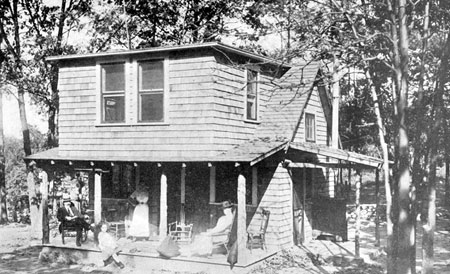| Join | Official Historian | City of Stamford | Blog | About Us | |
| Jewish Historical Society | Civil War Roundtable | Contact Us | |
|
|
|
|
Photo Archivist's Selection of the Month: May 2004A Woodland Home Made of Packing Boxes.Again, The Guide to Nature magazine, issue of December 1912, brings us a delightful article, this time about building and living in the wilds of what is now North Stamford.
|
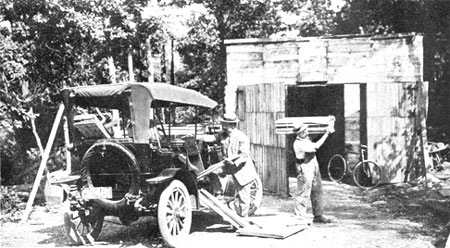 |
Contrary to what might be expected, the buildings are not in appearance poverty stricken shanties, but are well and substantially built, in good proportion, and with harmonious and appropriate architectural lines.
Here Mr. Delap and the members of his family frequently resort for rest, recreation and the study of nature.
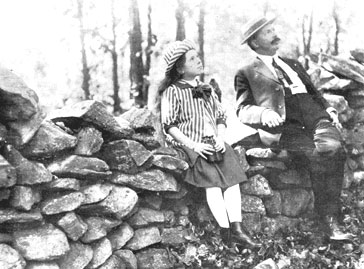 |
At no other home near to nature that I have visited, is there a better example than at this, of the meeting of the extremes of civilization, which here seem to come together and form a circle. Here is the wildest of primitive regions, but short daily visits to it would not be possible without the aid of that most modern of man's inventions--the automobile. The automobile has been working wonders and is still working wonders in thus making it possible to have frequent communion with nature. Not many years ago a nearness to nature was possible to the business man for only a short time during his short vacation, or perhaps a hunting trip in midwinter, or a mid-summer fishing excursion to some remote part of Maine. But the automobile annihilated the distance between the busy centers of trade and the tangled thickets. Can one imagine a more perfect form of recreation or more literally a place in which to recreate, or a more successful antidote for the rush and strain of modern civilization, and the intense competition of business than to slip away to this spot for a few hours of relief from responsibility, to enjoy this intimate acquaintance with the rocks, the trees, the birds, the sunshine and the invigorating air? That is the right kind of approach to nature. It inflicts no cruelty upon any form of life.
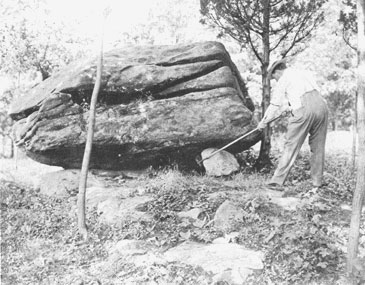 AS IF I MIGHT PULL IT OUT BY THIS HOE. But he couldn't nor could the combined strength of several men. |
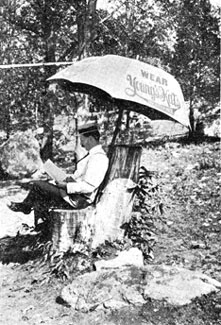 UNDER SOME CONDITIONS A MAN MAY TAKE HIS BUSINESS WITH HIM AND YET HAVE A VACATION! |
Mr. Delap has been a successful hunter in years past, but I note that he is becoming more and more disposed to lay the gun aside, and to go to nature for rest, refreshment and observation. What he has done hundreds of others are doing and will continue to do. The more frequently such methods are repeated and practised, the longer will be the life arid the greater the happiness of our business men. Nature for the recluse only is a thing of past ages, but nature for the modern business man is not only a new method for preventing nervous exhaustion and collapse, but it is successful. It is proving to be salvation from the evils of nerve strain. It works. It is successful. Mr. Delap is himself a proof of it. He apparently has no nerves. Those who visit his store well know his never failing geniality and wit. He always has a smile and a word of good cheer. I know where he gets and how he retains his vitality. The purpose of this article is to reveal the secret that others may go and do likewise. Ever notice what a difference there is between one store and another? How tense and strained is the tone that one finds in some, where everything is keyed up to concert pitch like the strings of a violin, while in others there is a cordial pleasantness, a geniality as soothing as the melodious tones of an organ. Perhaps the kind of geniality found in Mr. Delap's store may be susceptible of a musical explanation. I think the secret may be found in the songs of the birds, the murmur of the winds through the trees over that packing-box house, and the rippling laughter of the water in the ravine at the foot of the hill. Soon after my arrival I went to the ravine at the suggestion of the host. "There," he said, "is a beautiful place and I know you will enjoy the brook." That brook laughs not only there but in Mr. Delap's store. It sings in the charming hospitality of his home, in the kind greeting of his wife, an attractive and affable hostess, and not least in eyes and on the lips of his young daughter, the joy of the household, a veritable nymph of the woods, the fairy of the packing-box home, of the beautiful trees, the mighty boulders, the singing birds and the humming insects of Den Road.
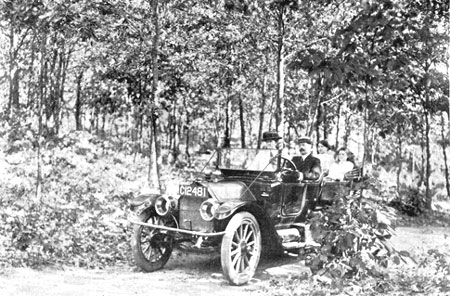 THE AUTOMOBILE ANNIHILATED THE DISTANCE BETWEEN THE BUSY CENTERS OF TRADE AND THE TANGLED THICKETS. Note |
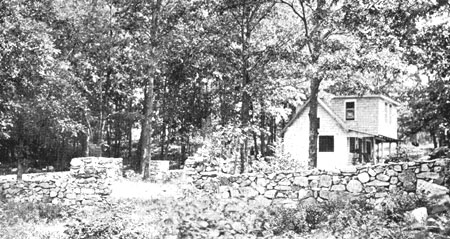 THE PACKING BOX HOME WITH MODERN STONE WALL DECORATION. |
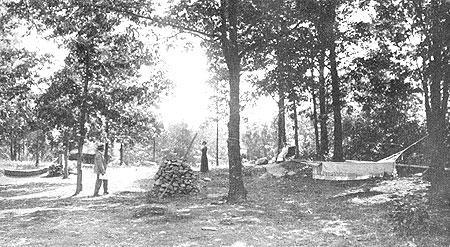 AN AIR OF REST AND CONTENTMENT. |
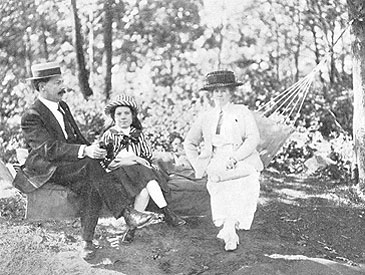 "FOR HE'S A JOLLY GOOD FELLOW" WHO LIKES TO HAVE HIS WIFE AND DAUGHTER WITH HIM TO TELL THEM HOW MUCH HE ENJOYS SOLITUDE (WITH THEM) IN THE WOODS! |
Building Homes Near to Nature, advertisments from the same issue.
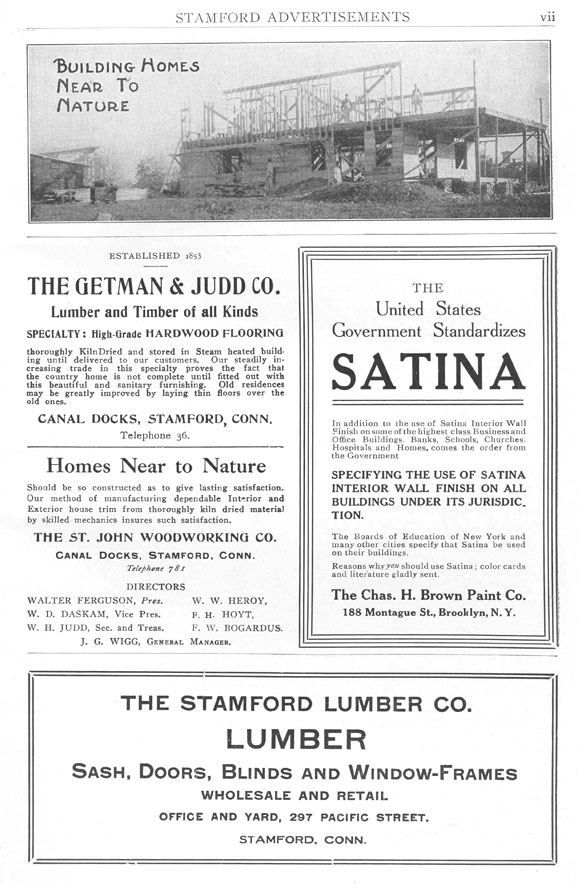
The Hartwell Delap Co. in the 1913 Stamford Directory
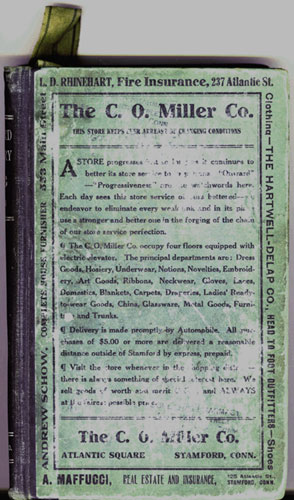 |
Front Cover, 1913 Stamford Register. The ad for Hartwell Delap Company runs along the right side.
|
Note: An inquiry on the Internet produced the following quote courtesy Kit Foster of the Society of Automotive Historians:
…the license plate tells me that Mr. Delap's car is a 1912 Reo "The Fifth," serial number 39731. I have a 1915 Connecticut Motor Vehicle Register book, and Mr. Delap, of 46 St. George Avenue, Stamford, was still driving it with registration C12481. A glance at the Standard Catalog of American Cars 1805–1942 confirms that it's a Reo.
Reo stands for Ransom Eli Olds
Another cottage in North Stamford: The Nature Studies and Recreations of a Business Man
Other Photo Archivist Selections of the Month
Photo Collection Information
 Volume V, Number 8, December 1912
Volume V, Number 8, December 1912